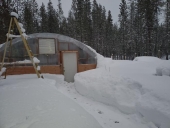posted 12 years ago
Hi Jamey,
We have used 55-gallon drum lids (and upside-down drums, so the bottom becomes the top) in these heaters for a number of years. If you put weight or a cold thermal mass (like a teakettle) off to one side, you may see some slight warping as the surface heats and cools. But if both the heat and any cookware are roughly centered on the drum, even the food-grade barrels hold up nicely. (There are different gauges of barrel, so if you are concerned you can look for a sturdier fuel-grade barrel, or even make a custom steel cylinder / octagon if you have airtight welding skills.)
Regarding the J-tube / L-tube:
The L-tube basically shortens the burn chamber and removes 1 turn. So the fire may not burn as clean. It also requires manually feeding the wood in, so the air and wood-gas aren't pre-mixed like in a J-tube. But it does operate a lot more like a conventional woodstove as far as loading goes, and this can be more comfortable for many people learning to tend the sideways fire.
The J-tube offers self-feeding, better pre-mixing, and a longer firebox channel with more turns for a more complete burn. The trick with the J-tube is to remember it's a siphon: you have to get the proportions right, meaning a relatively tall heat riser compared with your feed height, and then keep it full (no air leaks or fallen-down wood). The wood should entirely fit within the feed (not taller), so that if needed you can force air downward by restricting the air at the feed to about 1/2 the opening.
The rest of your heater's drag or draft, and any wind or building pressure issues, can impact the smokeback issue too. We have seen numerous stoves that draft fine under many conditions, but puff smoke if the fire gets low and the prevailing wind is coming from the wrong direction. This is one reason we like the vertical exhaust chimney (to above the roof ridge). Spendier, but more reliable in conventional modern buildings.
I might suggest taking a look at our O&M manual, which is up on our online store right now for $3. There is a pretty extensive troubleshooting section if you want to see other things that might help with smokeback. I'll have the full design parameters and a sample design in our Builder's Guide, which I hope will be coming out soon!
Yours,
Erica W











